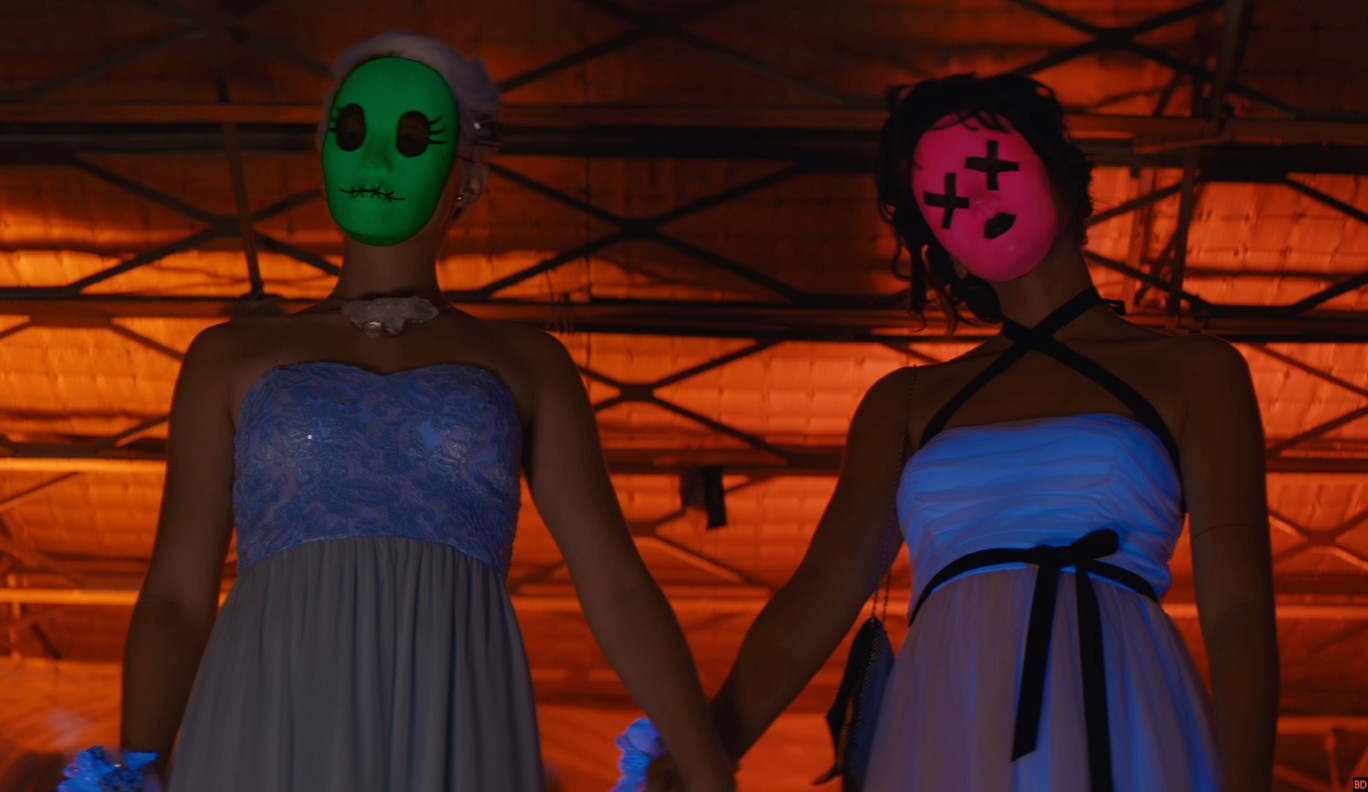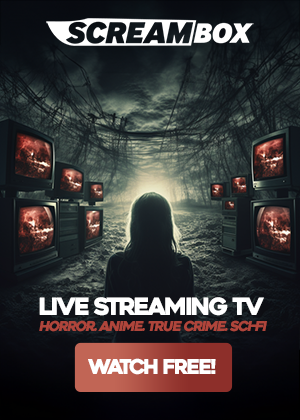Editorials
Strong Female Leads Start Killing in ‘I Blame Society’ and ‘Tragedy Girls’ [Double Trouble]

In the final moments of I Blame Society, Gillian Wallace Horvat goes absolutely apeshift on a couple of film bros. “I am a strong female lead,” she grunts as she wields a blade across the throat of Producer #2. Blood spurts and covers the walls. The screen is coated in thick red plasma, leaving the film title seeping through. That solitary line punctures the graphic violence with sardonic humor, circling back to an earlier conversation when the same film bros eviscerated Gillian’s latest script for not having a compelling enough protagonist. The venomous refrain encompasses not only the entire thesis of the found-footage film but what it’s like to be anyone but a cis white man in the world.
“I am a strong female lead” could also read as the thematic premise to Tragedy Girls 一 a flashy, meta-slasher led by Sadie (Brianna Hildebrand) and McKayla (Alexandra Shipp), two high-schoolers desperately wanting to make a name for themselves within the serial killer arena. I Blame Society is a Making a Murderer demonstration, confined to one artist’s morally-questionable conceits in capturing authentic art; whereas, Tragedy Girls explores a very different hunt for authenticity, a comment on fame and online popularity through a murderous lens. Both films reside within the same blood-soaked realm; three women rising triumphant after clawing their way through the thorny thicket of the patriarchy.
Horvat originally conceived a documentary based upon a compliment she received from friends. “You’d make a great murderer,” they told her. She then set to work compiling interviews with friends, family, and exes 一 but the idea never felt truly complete. She shelved the project, only to return a few years later when producers Mette-Marie Kongsved and Laura Tunstall watched the short film and suggested fleshing it out in a found-footage format. It was like a lightning bolt of creativity, and it was off to the races from there. The set-up in I Blame Society is much the same: Horvat, who plays an exaggerated version of herself, swinging from deadpan to unhinged, plots a mockumentary (titled i, Murderer) around the murderer compliment. She chronicles her every move, from the hilarious introduction in which she proposes killing her friend Chase’s abusive, emotionally-manipulative girlfriend, to how she would theoretically commit the crime.
Three years later, the friendship has understandably fallen apart, and Gillian is going through a period of creative stagnation and toys with graduate work in law. She’s written several other scripts, including one about Israel, but everyone in her life, including her manager (who drops her), finds the lead character uninspired and uninteresting. Back to the drawing board, she decides on resurrecting the murderer mockumentary and forging ahead with her career. “I can’t sit back and wait for permission from some guy to make a movie,” she tells her camera assistant Olivia.
Through i, Murderer, Gillian traces out the “whole arc of a murderer’s career” and the “progression of thrills.” Things begin with something simple, and she shoplifts a bottle of cough syrup from a local pharmacy. Later that night, she works on a collection of knots she may use for the film process and shares with her boyfriend further ideas she has. Exhausted from the day, he complains about working with a progressive woman director and makes a misogynistic joke about Gillian’s filmmaking ambitions. “Are you making a porn now? Is that all you know how to do?” he jests, shrugging it off. The comment grossly underestimates Gillian’s power, and she takes it as fuel for her art.
Gillian plunges into the underbrush of her plan. She scouts out potential locations and targets, first spying a woman with a dog (that’s a no-go from the start) and then someone she surmises as an actress. Bingo! The woman leaves in a rush, and Gillian takes the opportunity to scope out the apartment, pointing out the advantages of carpet over hardwood, and begins proofing the space for her eventual breaking and entering. Amidst her preparations, she gets a call from her former manager’s assistant about a promising high-profile meeting with two producers (the aforementioned film bros). “We need an ally on your side!” Producer #1 and Producer #2 stress, spouting some nonsense about intersectionality within the company. Of course, it’s all performative jargon to seem inclusive; they don’t even give Gillian the floor to discuss her own work. They’d rather give her a menial task in creating a lookbook for another man’s greenlit project. Typical.
It’s a mere bump in the road for her, though. Misogynists will be misogynists. She plows further into the mockumentary. The second step is invading the woman’s apartment while she is present. In the witching hour, Gillian creeps into the window and sets up a series of hidden cameras throughout each room. She goes above and beyond in the scheme, even making herself at home and grabbing a slice of apple and a glass of wine. “I’m living my best life,” she whispers to the camera, as she sits bedside her prey. A creative by nature, she goes all-in on method. It’s both chilling and hilarious.
Gillian’s devolution doesn’t hit into overdrive until reconnecting with Chase, who breaks the silence after three years. They meet up for a hike to chit chat and get a little exercise in. Chase talks about everything, from how he’s doing these days to upcoming nuptials. This sets Gillian off into an epically-deranged monologue about him marrying “the fucking devil.” Chase is bewildered, hurt, and angry at her allegations 一 but has little time to challenge her before he succumbs to a deadly sesame seed allergy. Having no knowledge of this, Gillian claims that she assumed he just didn’t like sesame seeds on his bagel and merely wiped them off. Gasping for air, Chase lies writhing in the sun and squeaks out that he has an EpiPen in his bag. Gillian scavenges for it, but before she stabs him with the medicine, she pleads with him to make her a promise that he won’t marry The Devil. Life fades from his face, and he lies motionless.
It’s just the trigger Gillian needed to send her careening down a path of utter destruction. She kills a myriad of people 一 a calculated decision so as not to alert authorities with a discernible pattern 一 including the actress, a homeless man, and an egomaniac working as an insurance agent. Each slaying tantalizes her and gives her the most intoxicating high. And she’s not even close to being done. “You can’t anticipate me. You can’t predict me,” she stares down the viewer. The stunningly creepy monologue arrives during one of her midnight murders, interspersed with comments on how the police have no idea who could be behind such a sweeping epidemic. Naturally, they peg the killer as a man; how could a woman possibly commit such atrocities anyway? Gillian’s icy smirk says it all.
In a similar vein to Behind the Mask: The Rise of Leslie Vernon, I Blame Society fully displays the messiness of becoming a murderer. She’s not a natural born killer, but it’s evident through a series of trial and error exploits that her bloodlust lurks in the deep recesses of her soul.
Tragedy Girls’ Sadie and McKayla, on the other hand, are explicitly driven by some murderous impulse. Paired with their sick hunger to be famous, it creates the perfect storm in transforming them into this generation’s next big psychopaths. “Sometimes, I think nothing I do matters,” expresses Sadie over lunch one afternoon. Her rare confession exposes the insecurities she masks with eye shadow and an imposing presence, matched only with McKayla’s equally-fierce character. Both exude confidence, and as they discover through their murder campaign, no one ever takes women seriously.
The film opens with Sadie swapping spit with a boy named Greg. From the vintage automobile and the moody atmosphere, it’s a scene straight out of any ‘80s slasher flick. But there’s a flip. Sadie is on a mission to lure Lowell Orson Lehmann (Kevin Durand), a real life serial killer after whom they’ve modeled their own ambitions. Like clockwork, Lowell shows up and slaughters Greg in the most grotesque way, giving Sadie and McKayla a window to pounce and take him hostage. “Make no mistake who’s in charge, bitch!” spits McKayla, once they have Lowell bound inside an isolated shed. They profess their admiration for his work and rising body count (five so far) but are quickly disappointed when they have to finish off Sadie’s little boy toy themselves. “You couldn’t even do that right,” chides McKayla.
Sadie and McKayla then map out their entire process, from stalking potential victims to keeping a keen eye on the media. In one of the film’s funniest bits, the duo note the distinction between serial killers and spree killers in a claymation featurette for their YouTube channel. With the help of Jack Quaid’s ever-adorable Jordan Welch, they upload frequent detailed reports as a way to appear with their finger on the pulse, aside from chasing down a higher follower count, of course. It’s all about the theatrics for them, each public display a chance to hurl their stardom further into the sun.
While their morals are skewed, their relationship and love for one another is not, a key element director Tyler MacIntyre wrote into the script. Their commitment to each other and the cause pours forth through murderous binges, as they perfect the crime scenes and the methodical skillset it takes to exact such a plot. With the media naming the killer a male (because duh!) and ruling various deaths as accidents or suicides, McKayla and Sadie are forced to get creative and escalate things. When they off the know-it-all cheerleading captain, it looks like a freak accident, so they chop up her body into gooey parts to make sure there’s no possible way it could be ruled anything but murder. McKayla’s ex-boyfriend Toby (Josh Hutcherson), gym trainer Al (Craig Robinson), and eventually Jordan fall by the wayside.
Despite a temporary detour in their relationship, Sadie and McKayla could never stay permanently estranged. Even the allure of fame as a solo Tragedy Girl doesn’t satisfy Sadie for long. She cares too much and too deeply for her lifelong BFF. In the grand finale, they undergo the ultimate test and conquer Lowell once and for all, thus usurping his throne as the perfect boss bitch villains. They lock hands and slide their neon-colored masks down over their faces. Iconic. Together, they’ve mastered the art of serial killing, and their friendship simply grows more powerful because of it. Borrowing a sentiment from Thelma & Louise, they pack up their entire lives in a convertible and ride off in the sunset.
Tragedy Girls and I Blame Society sees women taking charge 一 of their careers, self-worth, bodily autonomy, and ability to take up space in the world. Where one is a highly-polished meta-slasher bonanza, the other carries a grittier, more disheveled tone in found-footage style. They are two sides to the same feminist coin (and we love to see it). On their own, each film has claimed an indelible place in the modern pantheon of woman-led horror, and jointly, it’s a volatile and electrifying double feature. Spin-off sequel with Sadie, McKayla, and Gillian when?
Double Trouble is a recurring column that pairs up two horror films, past or present, based on theme, style, or story.

Editorials
‘A Haunted House’ and the Death of the Horror Spoof Movie

Due to a complex series of anthropological mishaps, the Wayans Brothers are a huge deal in Brazil. Around these parts, White Chicks is considered a national treasure by a lot of people, so it stands to reason that Brazilian audiences would continue to accompany the Wayans’ comedic output long after North America had stopped taking them seriously as comedic titans.
This is the only reason why I originally watched Michael Tiddes and Marlon Wayans’ 2013 horror spoof A Haunted House – appropriately known as “Paranormal Inactivity” in South America – despite having abandoned this kind of movie shortly after the excellent Scary Movie 3. However, to my complete and utter amazement, I found myself mostly enjoying this unhinged parody of Found Footage films almost as much as the iconic spoofs that spear-headed the genre during the 2000s. And with Paramount having recently announced a reboot of the Scary Movie franchise, I think this is the perfect time to revisit the divisive humor of A Haunted House and maybe figure out why this kind of film hasn’t been popular in a long time.
Before we had memes and internet personalities to make fun of movie tropes for free on the internet, parody movies had been entertaining audiences with meta-humor since the very dawn of cinema. And since the genre attracted large audiences without the need for a serious budget, it made sense for studios to encourage parodies of their own productions – which is precisely what happened with Miramax when they commissioned a parody of the Scream franchise, the original Scary Movie.
The unprecedented success of the spoof (especially overseas) led to a series of sequels, spin-offs and rip-offs that came along throughout the 2000s. While some of these were still quite funny (I have a soft spot for 2008’s Superhero Movie), they ended up flooding the market much like the Guitar Hero games that plagued video game stores during that same timeframe.

You could really confuse someone by editing this scene into Paranormal Activity.
Of course, that didn’t stop Tiddes and Marlon Wayans from wanting to make another spoof meant to lampoon a sub-genre that had been mostly overlooked by the Scary Movie series – namely the second wave of Found Footage films inspired by Paranormal Activity. Wayans actually had an easier time than usual funding the picture due to the project’s Found Footage presentation, with the format allowing for a lower budget without compromising box office appeal.
In the finished film, we’re presented with supposedly real footage recovered from the home of Malcom Johnson (Wayans). The recordings themselves depict a series of unexplainable events that begin to plague his home when Kisha Davis (Essence Atkins) decides to move in, with the couple slowly realizing that the difficulties of a shared life are no match for demonic shenanigans.
In practice, this means that viewers are subjected to a series of familiar scares subverted by wacky hijinks, with the flick featuring everything from a humorous recreation of the iconic fan-camera from Paranormal Activity 3 to bizarre dance numbers replacing Katy’s late-night trances from Oren Peli’s original movie.
Your enjoyment of these antics will obviously depend on how accepting you are of Wayans’ patented brand of crass comedy. From advanced potty humor to some exaggerated racial commentary – including a clever moment where Malcom actually attempts to move out of the titular haunted house because he’s not white enough to deal with the haunting – it’s not all that surprising that the flick wound up with a 10% rating on Rotten Tomatoes despite making a killing at the box office.
However, while this isn’t my preferred kind of humor, I think the inherent limitations of Found Footage ended up curtailing the usual excesses present in this kind of parody, with the filmmakers being forced to focus on character-based comedy and a smaller scale story. This is why I mostly appreciate the love-hate rapport between Kisha and Malcom even if it wouldn’t translate to a healthy relationship in real life.
Of course, the jokes themselves can also be pretty entertaining on their own, with cartoony gags like the ghost getting high with the protagonists (complete with smoke-filled invisible lungs) and a series of silly The Exorcist homages towards the end of the movie. The major issue here is that these legitimately funny and genre-specific jokes are often accompanied by repetitive attempts at low-brow humor that you could find in any other cheap comedy.

Not a good idea.
Not only are some of these painfully drawn out “jokes” incredibly unfunny, but they can also be remarkably offensive in some cases. There are some pretty insensitive allusions to sexual assault here, as well as a collection of secondary characters defined by negative racial stereotypes (even though I chuckled heartily when the Latina maid was revealed to have been faking her poor English the entire time).
Cinephiles often claim that increasingly sloppy writing led to audiences giving up on spoof movies, but the fact is that many of the more beloved examples of the genre contain some of the same issues as later films like A Haunted House – it’s just that we as an audience have (mostly) grown up and are now demanding more from our comedy. However, this isn’t the case everywhere, as – much like the Elves from Lord of the Rings – spoof movies never really died, they simply diminished.
A Haunted House made so much money that they immediately started working on a second one that released the following year (to even worse reviews), and the same team would later collaborate once again on yet another spoof, 50 Shades of Black. This kind of film clearly still exists and still makes a lot of money (especially here in Brazil), they just don’t have the same cultural impact that they used to in a pre-social-media-humor world.
At the end of the day, A Haunted House is no comedic masterpiece, failing to live up to the laugh-out-loud thrills of films like Scary Movie 3, but it’s also not the trainwreck that most critics made it out to be back in 2013. Comedy is extremely subjective, and while the raunchy humor behind this flick definitely isn’t for everyone, I still think that this satirical romp is mostly harmless fun that might entertain Found Footage fans that don’t take themselves too seriously.

















You must be logged in to post a comment.